AMD Ryzen 9 5980HS Cezanne Review: Ryzen 5000 Mobile Tested
by Dr. Ian Cutress on January 26, 2021 9:00 AM EST- Posted in
- CPUs
- AMD
- Vega
- Ryzen
- Zen 3
- Renoir
- Notebook
- Ryzen 9 5980HS
- Ryzen 5000 Mobile
- Cezanne
Our previous set of ‘office’ benchmarks have often been a mix of science and synthetics, so this time we wanted to keep our office section purely on real world performance.
Agisoft Photoscan 1.3.3: link
The concept of Photoscan is about translating many 2D images into a 3D model - so the more detailed the images, and the more you have, the better the final 3D model in both spatial accuracy and texturing accuracy. The algorithm has four stages, with some parts of the stages being single-threaded and others multi-threaded, along with some cache/memory dependency in there as well. For some of the more variable threaded workload, features such as Speed Shift and XFR will be able to take advantage of CPU stalls or downtime, giving sizeable speedups on newer microarchitectures.
For the update to version 1.3.3, the Agisoft software now supports command line operation. Agisoft provided us with a set of new images for this version of the test, and a python script to run it. We’ve modified the script slightly by changing some quality settings for the sake of the benchmark suite length, as well as adjusting how the final timing data is recorded. The python script dumps the results file in the format of our choosing. For our test we obtain the time for each stage of the benchmark, as well as the overall time.
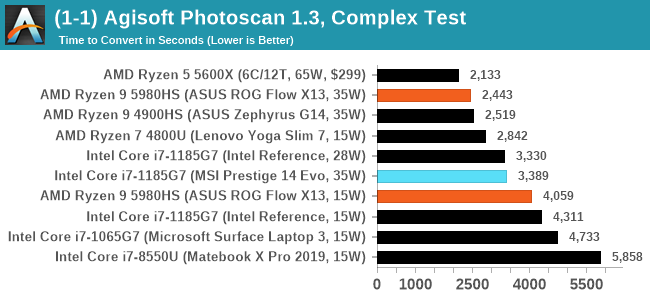
The new Zen 3 system offers a small speed up over the previous generation, and a large lead over the Intel competition here.
Application Opening: GIMP 2.10.18
First up is a test using a monstrous multi-layered xcf file to load GIMP for the first time. While the file is only a single ‘image’, it has so many high-quality layers embedded it was taking north of 15 seconds to open and to gain control on the mid-range notebook I was using at the time. This test is also the run where GIMP optimizes itself, and the optimization requirements scale linearlly with the number of threads in the system.
What we test here is the first run - normally on the first time a user loads the GIMP package from a fresh install, the system has to configure a few dozen files that remain optimized on subsequent opening. For our test we delete those configured optimized files in order to force a ‘fresh load’ each time the software in run. As it turns out, GIMP does optimizations for every CPU thread in the system, which requires that higher thread-count processors take a lot longer to run. So the test runs quick on systems with fewer threads, however fast cores are also needed.
We measure the time taken from calling the software to be opened, and until the software hands itself back over to the OS for user control. The test is repeated for a minimum of ten minutes or at least 15 loops, whichever comes first, with the first three results discarded.
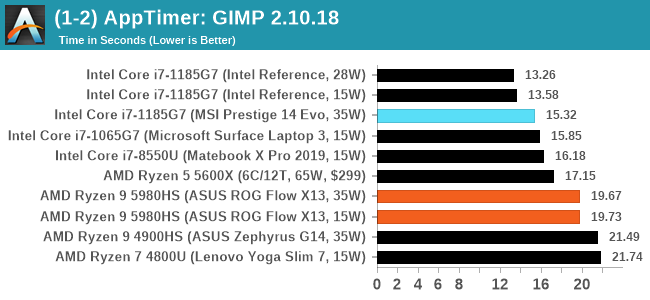
Due to the fast cores and fewer threads, Tiger Lake wins here, but AMD's new processor does offer a good 10% speed up generation over generation.
RISCV Toolchain Compile
Our latest test in our suite is the RISCV Toolchain compile from the Github source. This set of tools enables users to build software for a RISCV platform, however the tools themselves have to be built. For our test, we're running a complete fresh build of the toolchain, including from-stratch linking. This makes the test not a straightforward test of an updated compile on its own, but does form the basis of an ab initio analysis of system performance given its range of single-thread and multi-threaded workload sections. More details can be found here.

This is a new test, so we are still filling in data points with systems we still have at hand.
Science
In this version of our test suite, all the science focused tests that aren’t ‘simulation’ work are now in our science section. This includes Brownian Motion, calculating digits of Pi, molecular dynamics, and for the first time, we’re trialing an artificial intelligence benchmark, both inference and training, that works under Windows using python and TensorFlow. Where possible these benchmarks have been optimized with the latest in vector instructions, except for the AI test – we were told that while it uses Intel’s Math Kernel Libraries, they’re optimized more for Linux than for Windows, and so it gives an interesting result when unoptimized software is used.
3D Particle Movement v2.1: Non-AVX and AVX2/AVX512
This is the latest version of this benchmark designed to simulate semi-optimized scientific algorithms taken directly from my doctorate thesis. This involves randomly moving particles in a 3D space using a set of algorithms that define random movement. Version 2.1 improves over 2.0 by passing the main particle structs by reference rather than by value, and decreasing the amount of double->float->double recasts the compiler was adding in.
The initial version of v2.1 is a custom C++ binary of my own code, and flags are in place to allow for multiple loops of the code with a custom benchmark length. By default this version runs six times and outputs the average score to the console, which we capture with a redirection operator that writes to file.
For v2.1, we also have a fully optimized AVX2/AVX512 version, which uses intrinsics to get the best performance out of the software. This was done by a former Intel AVX-512 engineer who now works elsewhere. According to Jim Keller, there are only a couple dozen or so people who understand how to extract the best performance out of a CPU, and this guy is one of them. To keep things honest, AMD also has a copy of the code, but has not proposed any changes.
The 3DPM test is set to output millions of movements per second, rather than time to complete a fixed number of movements.
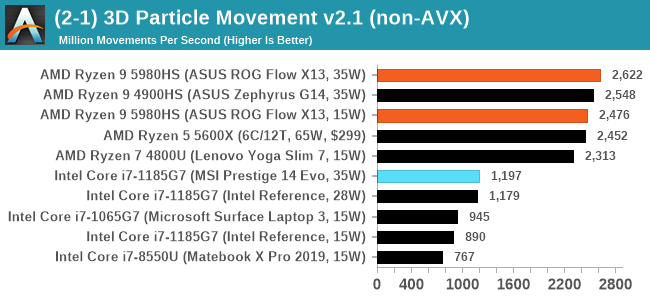
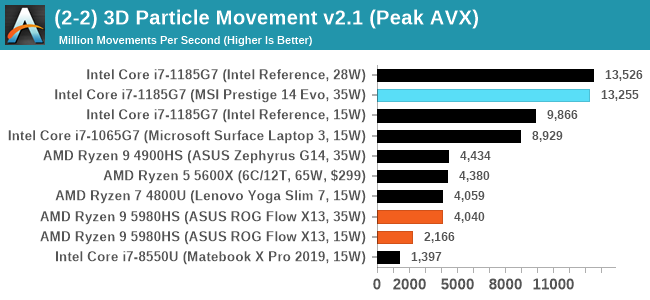
Intel's Tiger Lake has AVX-512 units, which is why they are so far ahead in the peak AVX test. For AMD vs AMD, we're seeing around the same score between the previous generation Zephyrus and the new Flow X13, however in multithreaded the Flow X13 seems to regress slightly.
y-Cruncher 0.78.9506: www.numberworld.org/y-cruncher
If you ask anyone what sort of computer holds the world record for calculating the most digits of pi, I can guarantee that a good portion of those answers might point to some colossus super computer built into a mountain by a super-villain. Fortunately nothing could be further from the truth – the computer with the record is a quad socket Ivy Bridge server with 300 TB of storage. The software that was run to get that was y-cruncher.
Built by Alex Yee over the last part of a decade and some more, y-Cruncher is the software of choice for calculating billions and trillions of digits of the most popular mathematical constants. The software has held the world record for Pi since August 2010, and has broken the record a total of 7 times since. It also holds records for e, the Golden Ratio, and others. According to Alex, the program runs around 500,000 lines of code, and he has multiple binaries each optimized for different families of processors, such as Zen, Ice Lake, Sky Lake, all the way back to Nehalem, using the latest SSE/AVX2/AVX512 instructions where they fit in, and then further optimized for how each core is built.
For our purposes, we’re calculating Pi, as it is more compute bound than memory bound. In single thread mode we calculate 250 million digits, while in multithreaded mode we go for 2.5 billion digits. That 2.5 billion digit value requires ~12 GB of DRAM, and so is limited to systems with at least 16 GB.

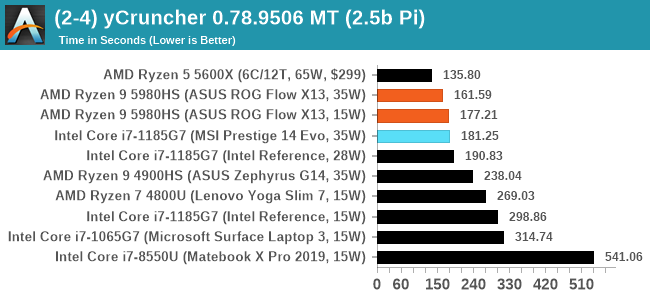
Intel here again benefits from AVX-512, however for a big multithreaded test, the eight cores of AMD pushes it ahead. Compared to the previous generation AMD processor, we see significant speedups for both ST and MT, showcasing the benefits of the new Zen 3 core and cache system.
NAMD 2.13 (ApoA1): Molecular Dynamics
One of the popular science fields is modeling the dynamics of proteins. By looking at how the energy of active sites within a large protein structure over time, scientists behind the research can calculate required activation energies for potential interactions. This becomes very important in drug discovery. Molecular dynamics also plays a large role in protein folding, and in understanding what happens when proteins misfold, and what can be done to prevent it. Two of the most popular molecular dynamics packages in use today are NAMD and GROMACS.
NAMD, or Nanoscale Molecular Dynamics, has already been used in extensive Coronavirus research on the Frontier supercomputer. Typical simulations using the package are measured in how many nanoseconds per day can be calculated with the given hardware, and the ApoA1 protein (92,224 atoms) has been the standard model for molecular dynamics simulation.
Luckily the compute can home in on a typical ‘nanoseconds-per-day’ rate after only 60 seconds of simulation, however we stretch that out to 10 minutes to take a more sustained value, as by that time most turbo limits should be surpassed. The simulation itself works with 2 femtosecond timesteps. We use version 2.13 as this was the recommended version at the time of integrating this benchmark into our suite. The latest nightly builds we’re aware have started to enable support for AVX-512, however due to consistency in our benchmark suite, we are retaining with 2.13. Other software that we test with has AVX-512 acceleration.
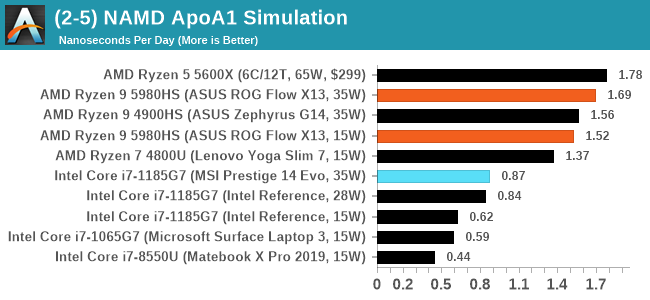
NAMD also sees good speedups, and the eight core mobile processor is within reach of that six-core desktop processor. Intel lags behind on the 2.13 version, as we wait for the AVX-512 to come out of alpha versions of the software.
AI Benchmark 0.1.2 using TensorFlow: Link
Finding an appropriate artificial intelligence benchmark for Windows has been a holy grail of mine for quite a while. The problem is that AI is such a fast moving, fast paced word that whatever I compute this quarter will no longer be relevant in the next, and one of the key metrics in this benchmarking suite is being able to keep data over a long period of time. We’ve had AI benchmarks on smartphones for a while, given that smartphones are a better target for AI workloads, but it also makes some sense that everything on PC is geared towards Linux as well.
Thankfully however, the good folks over at ETH Zurich in Switzerland have converted their smartphone AI benchmark into something that’s useable in Windows. It uses TensorFlow, and for our benchmark purposes we’ve locked our testing down to TensorFlow 2.10, AI Benchmark 0.1.2, while using Python 3.7.6.
The benchmark runs through 19 different networks including MobileNet-V2, ResNet-V2, VGG-19 Super-Res, NVIDIA-SPADE, PSPNet, DeepLab, Pixel-RNN, and GNMT-Translation. All the tests probe both the inference and the training at various input sizes and batch sizes, except the translation that only does inference. It measures the time taken to do a given amount of work, and spits out a value at the end.
There is one big caveat for all of this, however. Speaking with the folks over at ETH, they use Intel’s Math Kernel Libraries (MKL) for Windows, and they’re seeing some incredible drawbacks. I was told that MKL for Windows doesn’t play well with multiple threads, and as a result any Windows results are going to perform a lot worse than Linux results. On top of that, after a given number of threads (~16), MKL kind of gives up and performance drops of quite substantially.
So why test it at all? Firstly, because we need an AI benchmark, and a bad one is still better than not having one at all. Secondly, if MKL on Windows is the problem, then by publicizing the test, it might just put a boot somewhere for MKL to get fixed. To that end, we’ll stay with the benchmark as long as it remains feasible.
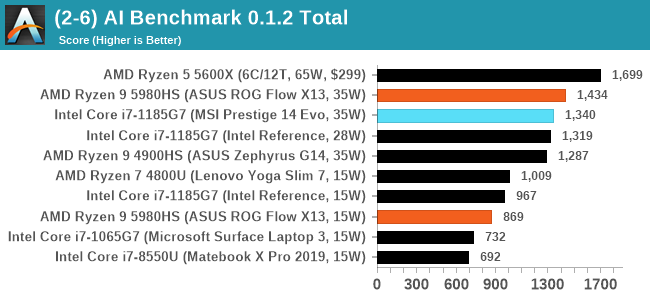
There's a good jump for AMD here generation-on-generation, pushing it ahead of Tiger Lake. At 15 W however, Intel would seem to have the upper hand.


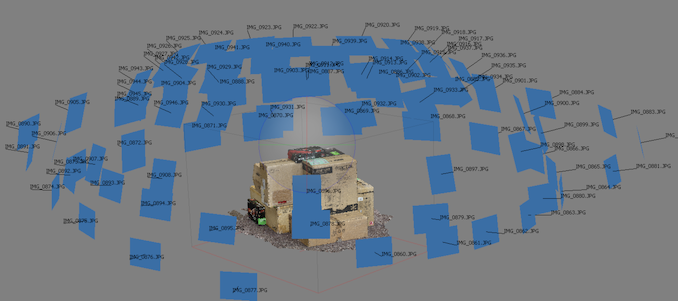
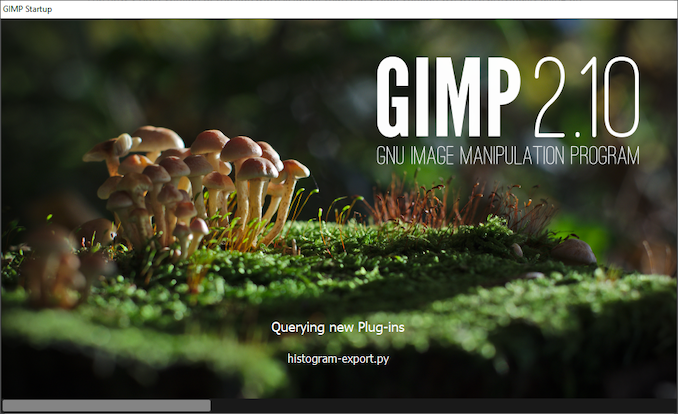
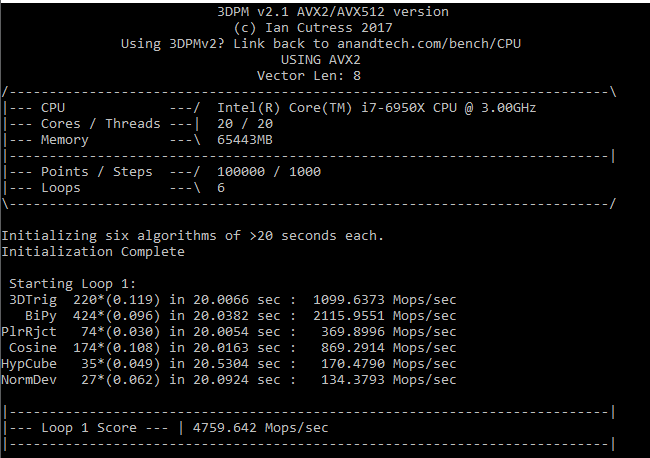

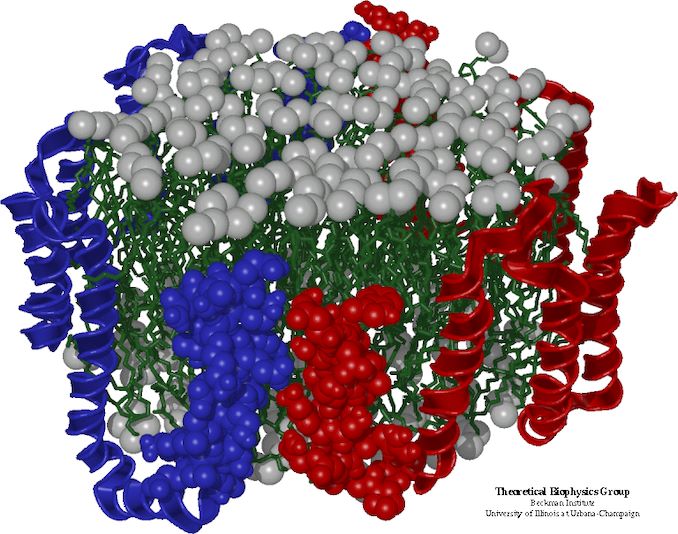









218 Comments
View All Comments
ToTTenTranz - Tuesday, January 26, 2021 - link
Is there any mention to the number and speed of PCIe lanes on Cezanne?I've been seeing reports of it only having x8 PCIe 3.0 lanes, which could present a problem to AMD's apparent goal of pairing Cezanne with discrete GPUs.
Also, I've read the explanation for the super weird resolutions chosen for the IGP tests, but it still comes off as rather irrelevant.
The author first claims the IGP is good for eSports, but then there are no eSports games being tested.
eSports is also apparently the reason the author is trying to pull >60FPS out of these SoCs, but I don't see a single title that anyone would want to play at those framerates.
The memory bandwidth limitation is also presented as a fact to be aware of, but then the author chooses very low render resolutions that are less likely to be impacted by memory bandwidth.
The Vega 8 at 2100MHz has a fillrate between the Xbox One and the PS4, a compute performance well above the PS4 and with LPDDR4X it has a memory bandwidth similar to that of the XBox One (without eDRAM).
IMO it would be a much more interesting procedure to test 8th-gen multiplatform games at resolutions and settings similar to the 8th-gen consoles, than trying to push Borderlands 3 to run at 90FPS at a 360p resolution that no one is ever going to enable.
The only useful result I see in there is FFXV at 720p medium.
Makaveli - Tuesday, January 26, 2021 - link
Why is apple silicon the "true challenge"I've already invested into the X86 eco system and all my software is there, why would I even consider an M1 regardless or performance?
And the same could be said for someone invested in the apple eco why would they even look at an x86 product?
pSupaNova - Tuesday, January 26, 2021 - link
Because a laptop that can run for hours/days with light use, is performant, does not need a fan is going to fly of the shelves.Watch Apple's market share explode as x86 users switch.
Ptosio - Tuesday, January 26, 2021 - link
I'm quite sure there'd be plenty Zen 3 designs that can run fanless for 10h+ with performance enough for 90% of users on the web/streaming/office etc. And that's before gets access to TSMC 5nm.For typical user invested in Windows/x86 software, there's still no compelling reason to switch to Apple silicon. Plus, at the price MacBooks go, you can get features unheard of in the Apple world, such as 4k OLED, touchscreen with stylus, 360 design, upgradable memory (affordable 32GB RAM and 4TB storage for less than Apple would charge for 8/1), discrete GPU with vast games' catalogue...
Not to take away from M1 superiority, but x86 is still simply good enough and would only get better.
Meteor2 - Thursday, February 4, 2021 - link
A typical user invested in x86 isn't going to change to Apple, no, but they're not the typical user. THE typical user is a lot more software-agnostic, and yes, ARM Apple is going to take marketshare. It's inevitable.Speedfriend - Wednesday, January 27, 2021 - link
Apple market share explode? That is hilarious. The average cost of a laptop sold last year was $400. Remind me what the cheapest Mac costs? Most purchasers have no idea about relative performance which is why they are still buying laptop with 8th generation Intel inside. Even battery life has little impact when x86 laptop claim to have up to 15 hours.Where Mac will take some share back is in professional designers where they had lost share over the past 5 years. But even then, the lack of multi monitor support may hamper that.
Deicidium369 - Wednesday, January 27, 2021 - link
Apple Market will expand slightly - but not from people moving from PC to Mac. People using a Mac by choice will continue to buy and use AppleThe hoops you need to jump thru for a 2nd monitor is kinda ridiculous - move designed to sell TB docking stations
Deicidium369 - Wednesday, January 27, 2021 - link
I get 12 or 13 hours from my Tiger Lake XPS13 - which is about 10 hours longer than I need...DigitalFreak - Tuesday, January 26, 2021 - link
IIRC, all their current mobile CPUs that support external graphics have 8 PCIe 3.0 lanes. That's more than enough for any dedicated GPU in a laptop right now.ToTTenTranz - Tuesday, January 26, 2021 - link
All current external GPUs have an immense bottleneck due to Thunderbolt 3.0 only using 4 PCIe 3.0 lanes.I don't know if Asus' 8x solution is enough, either.